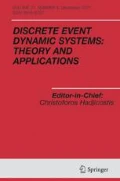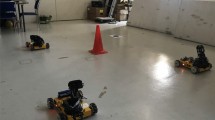Abstract
This research proposes an automatic strategy for planning a team of identical robots evolving in a known environment. The robots should satisfy a global task for the whole team, given in terms of a Linear Temporal Logic (LTL) formula over predefined regions of interest. A Robot Motion Petri Net (RMPN) system is used for modeling the evolution of the robotic team in the environment, bringing the advantage of a fixed topology versus the number of robots, with respect to methods based on synchronous automaton products. The algorithmic method iterates the selection of an accepted run that satisfies the specification and the search for RMPN sequences of reachable markings that can produce desired observations. A Büchi automaton witnesses the advancement towards formula fulfillment, and at the core of our methods are three Mixed Integer Linear Programming (MILP) formulations that yield firing sequences and markings of RMPN model. The cost functions of these formulations reduce the number of robot synchronizations and induce collision avoidance. Simulation examples support the computational feasibility of the proposed method.








Similar content being viewed by others
Notes
Such final synchronizations are needed in some cases of LTL formulas, e.g. requiring synchronous visits to some disjoint regions (Kloetzer et al. 2011).
References
Aragues R, Shi G, Dimarogonas D, Sagues C, Johansson K (2012) Distributed algebraic connectivity estimation for adaptive event-triggered consensus. In: American Control Conference (ACC), pp 32–37
Baier C, Katoen JP (2008) Principles of Model Checking. MIT Press
Belta C, Bicchi A, Egerstedt M, Frazzoli E, Klavins E, Pappas GJ (2007) Symbolic planning and control of robot motion. IEEE Robot Autom Mag 14 (1):61–71
Choset H, Lynch KM, Hutchinson S, Kantor G, Burgard W, Kavraki LE, Thrun S (2005) Principles of Robot Motion: Theory, Algorithms, and Implementations. MIT Press, Boston
Clarke EMM, Peled D, Grumberg O (1999) Model Checking. MIT Press
Costelha H, Lima P (2012) Robot task plan representation by Petri nets: modelling, identification, analysis and execution. Auton Robot 33(4):337–360
Dallal E, Colombo A, Del Vecchio D, Lafortune S (2017) Supervisory control for collision avoidance in vehicular networks using discrete event abstractions. Discrete Event Dynamic Systems 27(1):1–44
DeCastro J, Ehlers R, Runggers M, Balkan A, Kress-Gazit H (2016) Automated generation of dynamics-based runtime certificates for high-level control. Discrete Event Dynamic Systems 27(2):371—405
Ding X, Smith SL, Belta C, Rus D (2014) Optimal control of Markov decision processes with linear temporal logic constraints. IEEE Trans Autom Control 59(5):1244–1257
Ding XC, Kloetzer M, Chen Y, Belta C (2011) Automatic deployment of robotic teams. IEEE Robot Autom Mag 18(3):75–86
Duret-Lutz A, Lewkowicz A, Fauchille A, Michaud T, Renault E, Xu L (2016) Spot 2.0 - a framework for LTL and ω-automata manipulation. In: Proc of ATVA’16, LNCS 9938, pp 122–129
Esparza J, Heljanko K (2001) Implementing LTL model checking with net unfoldings. In: Proc of the 8th International SPIN Workshop on Model Checking of Software, pp 37–56
Fainekos GE, Girard A, Kress-Gazit H, Pappas GJ (2009) Temporal logic motion planning for dynamic robots. Automatica 45(2):343–352
Franceschelli M, Giua A, Pisano A (2014) Finite-time consensus on the median value by discontinuous control. In: American Control Conference (ACC), pp 946–951
Franceschelli M, Rosa D, Seatzu C, Bullo F (2013) Gossip algorithms for heterogeneous multi-vehicle routing problems. Nonlinear Analysis:, Hybrid Systems 10 (1):156–174
Garrido S, Moreno L, Gomez J, Lima P (2013) General path planning methodology for leader-follower robot formations. Int J of Advanced Robotic Systems 10(64):1–10
Gastin P, Oddoux D (2001) Fast LTL to büchi automata translation. In: Proc of the 13th Conference on Computer Aided Verification (CAV), LNCS 2102, pp 53–65
Guo M, Dimarogonas DV (2015) Multi-agent plan reconfiguration under local LTL specifications. The International Journal of Robotics Research 34(2):218–235
Holzmann G (2004) The Spin Model Checker, Primer and Reference Manual. Addison, Reading
IBM (2016) Ibm Ilog Cplex optimization studio. software. http://www.ibm.com/products/ilog-cplex-optimization-studio/ http://www.ibm.com/products/ilog-cplex-optimization-studio/
Kloetzer M, Ding XC, Belta C (2011) Multi-robot deployment from LTL specifications with reduced communication. In: IEEE Conference on Decision and Control and European Control Conference (CDC-ECC), pp 4867–4872
Kloetzer M, Mahulea C (2014) A Petri net based approach for multi-robot path planning. Discrete Event Dynamic Systems:, Theory and Applications 24(4):417–445
Kloetzer M, Mahulea C (2015) LTL-Based planning in environments with probabilistic observations. IEEE Trans Autom Sci Eng 12(4):1407–1420
Kloetzer M, Mahulea C (2016) Multi-robot path planning for syntactically co-safe LTL specifications. In: 13Th International Workshop on Discrete Event Systems (WODES), pp 452–458
Kloetzer M, Mahulea C, Colom JM (2013) Petri net approach for deadlock prevention in robot planning. In: IEEE 18Th Conf on Emerging Technologies Factory Automation (ETFA), Cagliari, Italy
Lacerda B, Lima P (2011) Designing petri net supervisors from LTL specifications. In: Proc. of Robotics: Science and Systems
LaValle SM (2006) Planning algorithms. Cambridge
Li Z, Wu N, Zhou M (2012) Deadlock control of automated manufacturing systems based on Petri nets - a literature review. IEEE Transactions on Systems, Man, and Cybernetics, Part C: Applications and Reviews 42(4):437–462
Lin L, Stefanescu A, Su R (2016) On distributed and parameterized supervisor synthesis problems. IEEE Trans Autom Control 61(3):777–782
Ma H, Koenig S (2017) AI Buzzwords explained: Multi-Agent path finding (MAPF). AI Matters 3(3):15–19
Ma H, Hoenig W, Cohen L, Uras T, Xu H, Kumar S, Ayanian N, Koenig S (2017) Overview: a hierarchical framework for plan generation and execution in multirobot systems. IEEE Intell Syst 32(6):6–12
Mahulea C, Kloetzer M (2018) Robot planning based on Boolean specifications using Petri net models. IEEE Trans Autom Control 63(7):2218–2225
Mahulea C, Kloetzer M (2014) Planning mobile robots with Boolean-based specifications. In: 53Rd IEEE Conference on Decision and Control (CDC), Los Angeles, USA
Makhorin A (2012) GNU linear programming kit. http://www.gnu.org/software/glpk/
Murata T (1989) Petri nets: Properties, analysis and applications. Proc IEEE 77(4):541–580
Parrilla L, Mahulea C, Kloetzer M (2017) RMTool:, recent enhancements. IFAC-PapersOnLine 50(1):5824–5830
Robla-Gómez S, Becerra VM, Llata JR, González-Sarabia E, Torre-Ferrero C, Pérez-Oria J (2017) Working together: a review on safe human-robot collaboration in industrial environments. IEEE Access 5(26):754–26,773
Roszkowska E, Reveliotis S (2013) A distributed protocol for motion coordination in free-range vehicular systems. Automatica 49:1639–1653
Schillinger P, Bürger M, Dimarogonas D (2018) Simultaneous task allocation and planning for temporal logic goals in heterogeneous multi-robot systems. Int J Robot Res 37(7):818–838
Sharon G, Stern R, Felner A, Sturtevant N (2015) Conflict-based search for optimal multi-agent pathfinding. Artif Intell 219:40–66
Sharon G, Stern R, Goldenberg M (2013) Felner a: the increasing cost tree search for optimal multi-agent pathfinding. Artif Intell 195:470–495
Sheridan TB (2016) Human robot interaction: Status and challenges. Hum Factors 58(4):525–532
Silva M, Teruel E, Colom JM (1998) Linear algebraic and linear programming techniques for the analysis of P/T net systems. Lecture on Petri Nets I:, Basic Models 1491:309–373
Theorin A, Bengtsson K, Provost J, Lieder M, Johnsson C, Lundholm T, Lennartson B (2017) An event-driven manufacturing information system architecture for industry 4.0. Int J Prod Res 55(5):1297–1311
Tumova J, Dimarogonas D (2016) Multi-agent planning under local LTL specifications and event-based synchronization. Automatica 70:239–248
Ulusoy A, Smith S, Ding X, Belta C (2012) Robust multi-robot optimal path planning with temporal logic constraints. In: 2012 IEEE Conference on Robotics and Automation (ICRA), pp 4693–4698
Ware S, Su R (2016) Incremental scheduling of discrete event systems. In: 13Th International Workshop on Discrete Event Systems (WODES), pp 147–152
Wolper P, Vardi M, Sistla A, et al. (1983) Reasoning about infinite computation paths, E.N.. In: Proceedings of the 24th IEEE Symposium on Foundations of Computer Science. AZ, Tucson, pp 185–194
Yen JY (1971) Finding the k shortest loopless paths in a network. Manag Sci 17 (11):712–716
Zhou Y, Hu H, Liu Y, Lin S, Dingm Z (2018) A distributed approach to robust control of multi-robot systems. Automatica 98:1–13
Acknowledgments
The first author acknowledges the support of Ministry of Research and Innovation (Romania) under CNCS-UEFISCDI grant PN-III-P1-1.1-TE-2016-0737. The second author acknowledges the support of the Aragonese Government (Spain) under grant T94 DisCo group, and of University of Zaragoza under grant JIUZ-2018-TEC-10.
Author information
Authors and Affiliations
Corresponding author
Additional information
Publisher’s note
Springer Nature remains neutral with regard to jurisdictional claims in published maps and institutional affiliations.
This article belongs to the Topical Collection: Smart Manufacturing - A New DES Frontier
Guest Editors: Rong Su and Bengt Lennartson
Rights and permissions
About this article
Cite this article
Kloetzer, M., Mahulea, C. Path planning for robotic teams based on LTL specifications and Petri net models. Discrete Event Dyn Syst 30, 55–79 (2020). https://doi.org/10.1007/s10626-019-00300-1
Received:
Accepted:
Published:
Issue Date:
DOI: https://doi.org/10.1007/s10626-019-00300-1




